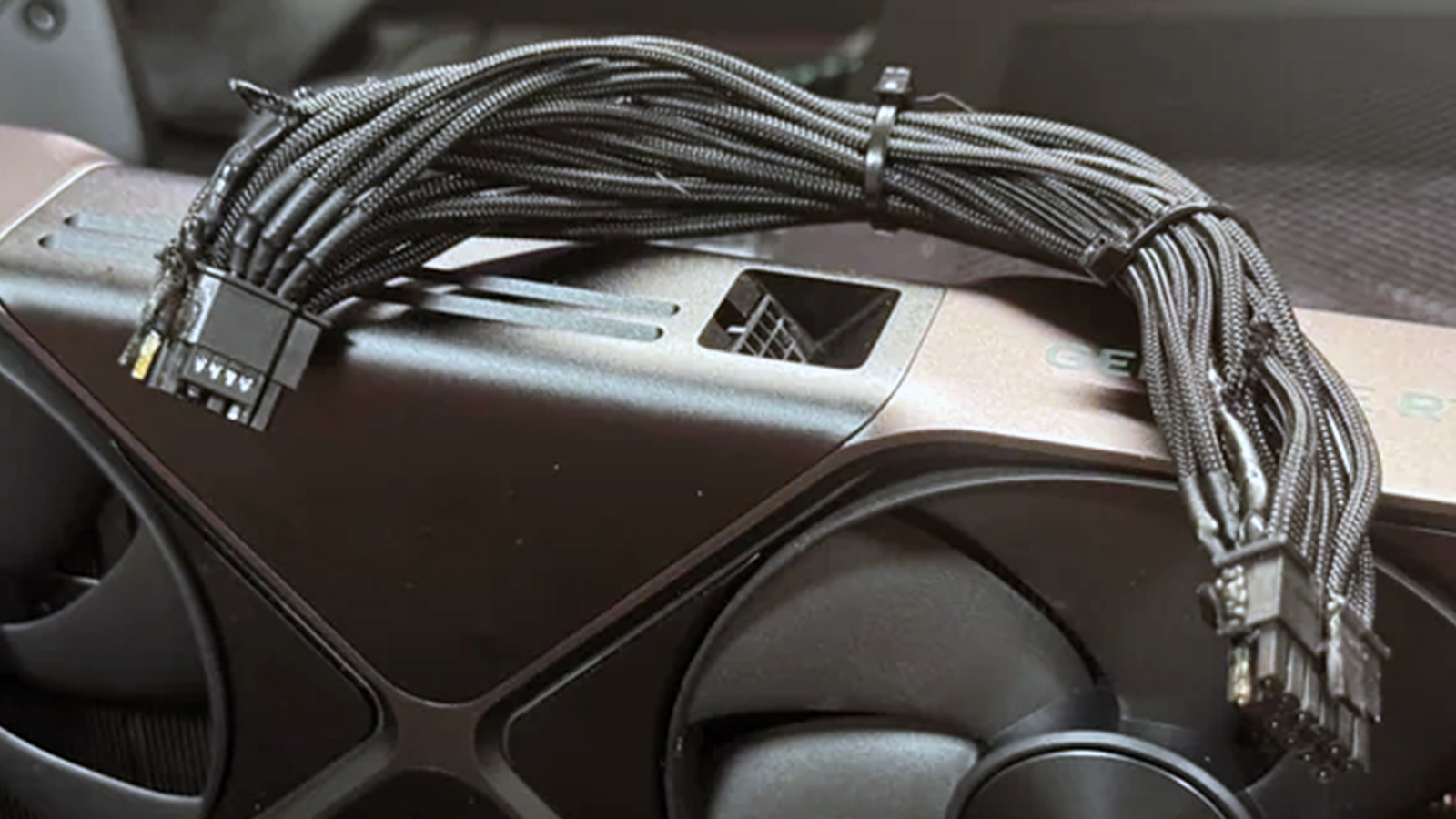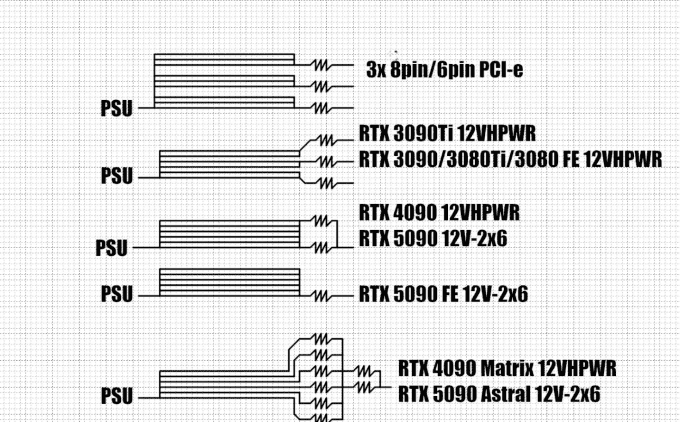Nvidia's RTX 5090 power cables may be doomed to burn
Widespread theory contends 16-pin ports are over-rated and under-protected by design.

As the RTX 50-series rollout continues, users are experiencing what seems to be a shockingly high rate of failure. The proprietary 12VHPWR/12V-2x6 cables providing power to the graphics cards have been seen melting inside the GPU slot of 5090 and 5080 cards. Nvidia was confident that users would no longer see the same issue that also plagued the RTX 4090 thanks to the redesigned 12V-2x6 connector, but multiple skeptics are raising their voices in dissent, asserting that Nvidia is making its cards less safe with each generation.
YouTube channel BuildZoid and an Intel engineer's viral Reddit post both claim that the 12VHPWR standard is being pushed too far for safety, from two different angles. BuildZoid contends that Nvidia has consistently removed safety regulations like shunt resistors from its cards generation-over-generation, contributing to a high risk of burning and other dangers.
Taking Away Shunt Resistors
Shunt resistors on GPUs monitor the flow of power from the cable and ensure that there is no overload. A 30-series and earlier Nvidia GPU would have multiple shunt resistors measuring current, allowing the card to balance its load by regulating power draw across each power connection. As illustrated by BuildZoid below, on cards using 8-pin and 6-pin power connections, a typical GPU has a shunt resistor for each plug. On the 30-series, Nvidia treated its 12V connector as three parallel 12V sources, allowing for regulating the power draw across the wires in the single connection.

On the 40- and 50-series cards, however, Nvidia downsized to two shunt resistors running into the same block. This means that even if there are two resistors, they both are received in the same input and in the same phase by the GPU, thus meaning the GPU cannot measure the flow across the connection. If anywhere from one to five wires break in the connection, the card will not know the difference.
With the max spec of the 12VHPWR connection being 600W, a cable with up to five wires broken could go from six wires pulling 100W each to one wire pulling 600W, resulting in a major problem. The card has no safety tools to know the difference and fire could break out. Confusingly, the 5090 Founder's Edition model downgrades to only one shunt resistor, exacerbating this potential risk.
Some aftermarket cards, such as the ASUS ROG Matrix 4090 and Astral 5090, add a secondary bank of shunt resistors before the consolidation of all of the pins. While the same bottleneck still occurs and power draw cannot be regulated appropriately in case of failure, the card can send a warning to users before a catastrophe occurs.
Over-Rated Pins
Reddit user Affectionate-Memory4, claiming to be an Intel electrical engineer, adds some further depth to this explanation as to why high-end cards keep burning at the power connection. The engineer contends that in addition to the lack of shunt resistors, all pins of a 16-pin 12V connection are consistently running at their amperage headroom with no breathing room, meaning the slightest change in atmospheric conditions may lead to failure.
Get Tom's Hardware's best news and in-depth reviews, straight to your inbox.
Standard 8-pin and 6-pin power connections are built to handle far more than they are rated for. An 8-pin connection is rated to carry 12.5A of current across all pins, with each pin at minimum spec required to carry 9A. Many modern PSU developers use products which are good for upwards of 10A, meaning an 8-pin connection with only two of its 12V wires functioning could appropriately power a connection at its required 150W with extremely low risk.
6-pins are even more overbuilt; only 2 or 3 of its pins carry 12V power, and at the minimum 9A spec, a single 12V pin of a 75W 6-pin connection has more margin of error than the entire 12VHPWR connection at full capacity. Suffice it to say 8-pin and 6-pin connections are built at extreme overkill, so the risks of severe damage even with a damaged cable are slim to none.
The 12VHPWR standard is not built anywhere near this same margin for failure. The micro-fit connectors used for 12VHPWR can only be found in 8.5A or 9A flavors, which is far from ideal for the 600W 12VHPWR connection. With six pins drawing 12V power, each pin is expected to carry 8.33A. This is right at the limit of 8.5A pins and still scarily close to 9A pins, and this is with a best-case scenario of a perfect-condition cable. A 600W draw is only 0.16A away from overloading its 8.5A pins, and yet it is within spec for the connection.
The 12VHPWR spec actually specifies a maximum permitted power draw of 375W at system startup, with 600W only allowed following software configuration. This 375W number allows for much looser margins of failure before problems are likely to arise. Likewise, a two-12VHPWR-cable GPU, if one ever exists, will operate outside of this issue.
Is this truly the answer?
We don't have enough data to argue this is the end-all, be-all answer for why we are seeing Nvidia GPU cables melting. The Reddit post comes from someone claiming to work for a direct competitor of Nvidia, which means its analysis should be taken with a grain of salt. Other explanations have begun to arise, such as inferior metals being used in the construction of non-Nvidia 12VHPWR/12V2x6 connections. And of course, Nvidia could have vastly improved VRMs on newer boards, which could regulate high power draws without needing shunt resistors.
Nvidia for its part has never issued a statement on why the cables have melted. Blaming user error for early melting mishaps, the company introduced the 12V2x6 cable revision during the lifespan of the 40-series, a revision that extended the pin lengths of the connection and ensured a working connection even if the cable was not seated perfectly. Moddiy, the third-party cable manufacturer known for having its cables investigated by Der8auer after the highest-profile recent incident, also walks a similar line, stating that newer 12V2x6 cables will not fail in the same way their older 12VHPWR did.
Whatever is to blame for cables melting and fire hazards being created, those looking to purchase RTX 5080 or 5090 series GPUs may want to consider options without the 12VHPWR connection, slim though they may be. Alternatively, you could wait a few weeks and see what (if any) other cable issues arise. Given the seemingly very limited stock since launch, it seems likely that most potential Blackwell buyers are already in that boat anyway.

Sunny Grimm is a contributing writer for Tom's Hardware. He has been building and breaking computers since 2017, serving as the resident youngster at Tom's. From APUs to RGB, Sunny has a handle on all the latest tech news.